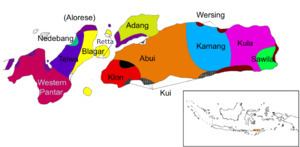Glottolog: alor1249 | ||
 | ||
Linguistic classification: Trans–New Guinea ?West Trans–New Guinea ?West Bomberai – Timor–Alor–Pantar ?Alor–Pantar Subdivisions: Alorvarious languages of Pantarperhaps Bunak | ||
The Alor–Pantar languages are a family of clearly related Papuan languages spoken on islands of the Alor archipelago near Timor in southern Indonesia. They may be most closely related to the non-Austronesian languages of western Timor, but this is not yet clear. A more distant relationship with the Trans–New Guinea languages of the Bomberai peninsula has been proposed based on pronominal evidence, but though often cited has never been firmly established.
Contents
Languages
The family is conventionally divided into two branches, centered on the islands of Alor and Pantar.
Tereweng is sometimes considered a separate language from Blagar, and Hamap sometimes separate from Adang. Abui, Kamang, and Kabola may also not be unitary languages.
The 15th edition of Ethnologue included Makasae as a third branch, but this is now known to be related instead to Oirata–Fataluku.
Holton, et al. (2012)
Holton, et al. (2012) propose the following classificatory subgrouping for the Alor–Pantar languages, with individual languages marked by italics.
"Proto-Alor–Pantar" may be synonymous with Proto-Timor–Alor–Pantar, as the languages outside the Alor branch do not seem to form a valid node with it against the Oirata–Makasai languages of East Timor and Bunak language on the Timorese border. However, the relationship is distant. Ross (2005) postulates a "West Timor" group uniting Alor–Pantar with Bunak. He reconstructs the pronouns as:
3pl *gi is not attested from Bunak, and the inclusive is just i.
Language documentation
Language documentation efforts in the early 21st century have produced a range of published documentary materials.
Classification
It has long been recognized that the Papuan languages of the Alor archipelago (including Alor and Pantar, as well as the four small islands of Buaya, Pura, Ternate, and Tereweng in the Pantar Strait) form a well-defined group. Apparent cognates among basic vocabulary are abundant, as demonstrated for example in Stokhof’s (1975) survey of basic vocabulary, and the shape of pronominal systems is almost identical across the group. The genetic relatedness of the Alor–Pantar languages has been confirmed through the reconstruction of the proto-Alor–Pantar language. Relationships between the Alor–Pantar languages and at least some (though perhaps not all) of the non-Austronesian languages of Timor Island may justify the positing of a Timor–Alor–Pantar language family, however the relationship between the AP group and the Timor languages is of a second order.
Based on an examination of possessive prefixes, Capell (1944) originally postulated that the AP languages were related to the West Papuan Phylum languages of North Maluku and the Bird’s Head of New Guinea. This hypothesis was later countered by Wurm et al. (1975), who classified these languages as members of the putative Trans–New Guinea Phylum. However, the authors offered little evidence for this classification and remained somewhat doubtful, noting, “whichever way they [the Timor–Alor–Pantar languages] are classified, they contain strong substratum elements of the other … phyla involved” (Wurm et al. 1975:318). Most recently, based on an analysis of pronominal shapes Ross (2005) assigns AP to his West Trans–New Guinea linkage, a subgroup of Trans–New Guinea. Yet Ross’ proposal requires that AP pronouns be derived from pTNG via a flip-flop in which second person pronouns trade places with third person. Compare pTNG *ŋga ‘2pro’ and *(y)a ‘3pro’ with Nedebang aŋ and gaŋ, respectively. Bottom-up reconstruction based on regular sound correspondences may shed further light on these issues.
